As Mother’s Day approached I naturally thought of my mom who died two summer’s ago. I miss her dearly and never tire of telling how she got me interested in the ecology movement of the late ‘60s. She was a simple farm girl growing up with a father who was for a while a tenant farmer in Centre County. For a while he managed a secluded hunting lodge where rich men from Philadelphia would decamp to camp. He was a trout fisherman, but mom wasn’t rugged or outdoorsy. She certainly was no bohemian – I pretended to be the family hippy and she did not approve.
But yet, she read (alongside Christy, Catherine Marshall’s Appalachian autobiography) Silent Spring, the groundbreaking anti-pesticide work of Rachel Carson, which was part nature writing and part expose about DDT. Mom loved birds (and cherished her ornamental plates with painted birds, and a few framed Ray Harm prints that rivaled the realism of Audubon.) She was sad that our modern stupidity would harm God’s creatures. It was pretty much as simple as that, I think – she loved nature, she loved birds, and while she was learning to be thoroughly modern, she understood that big corporations were doing bad things polluting our Earth. She got our little church youth group to pick up litter on that first Earth Day in 1970.
(By the way, as an aside: did you know that the remarkable Rachael Carson grew up in Western Pennsylvania? Her Springdale homestead is actually under care of a small Presbyterian church out there whose pastor over the years has been a good friend and faithful customer.)
So, even though mom was not a deeply literary reader, she truly delighted in the fruit trees and expansive fields of the home I grew up in and the small woods into which she and my dad moved in the early 1970s. She enjoyed trailer camping with my dad and in her elderly years liked going to see “the lake” at a local State Park.
This week’s BookNotes highlights recent titles about nature (which I prefer to call creation as per Norman Wirzba’s From Nature to Creation: A Christian Vision for Understanding and Loving Our World) that I think many of our customers will love. I share them now in my mother’s memory. I hope they inspire the serious readers among us to continue to dig into this long-standing genre of “nature writing” and, as the Psalmist insists, to see the very creation as that which worships God. The heavens speak and the trees clap their hands, you know. Mom would have liked to hear me talk about books like this, I know that; she might have even bought a few and placed them next to her Rachel Carson.
To order these or other good books, please click on the “order” button at the bottom of this column which takes you to our secure order form at the Hearts & Minds website where you can safely enter credit card info. Don’t forget to tell us how many copies you may want and what your shipping preferences are.
USPS “Media Mail” is cheapest but slow and often delayed. USPS “Priority Mail” is a few dollars more (depending on the size of the package, of course) but usually only takes a few days. UPS may be more reliable but most costly. Don’t hesitate to inquiry about exact costs, which we could determine after we know what you want, weigh the package, and enter the accurate address to determine an accurate charge. It is our pleasure to serve you.
ALL BOOKS MENTIONED – 20% OFF.
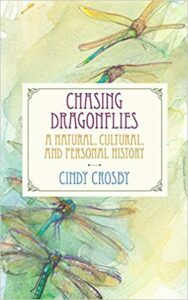 Chasing Dragonflies: A Natural, Cultural and Personal History Cindy Crosby, illustrated by Peggy Macnamara (Northwestern University press) $24.95 OUR SALE PRICE = $19.96
Chasing Dragonflies: A Natural, Cultural and Personal History Cindy Crosby, illustrated by Peggy Macnamara (Northwestern University press) $24.95 OUR SALE PRICE = $19.96
This lovely book was one of my absolute, favorite reads last summer as I sat outside reading day by day, late into the dusk. If it were not for the demands of our mail order business in the worst of the pandemic I would have dedicated a long review just to this, so taken was I with it. It is interesting, informative, funny, and at times so moving I had to wipe reluctant tears. I recommend it to anyone who cares about the outdoors and obviously to those who love the lovely little insect-like creatures.
Dragonflies are considered beautiful – and, in some places, considered fearsome – the world over. We all know that there are birdwatchers and most know there are those who are dedicated to tracking butterflies. Honeybees are now so endangered that folks follow them. Who knew that there are clubs and groups and scholarly researchers – including what Crosby calls “citizen scientists” – who painstakingly track these odes?
Crosby is a good and honest writer and she says, without sentimentality, that “dragonflies changed by life.” The story is one she unfolds as she speaks about her depression, her faith, the solace found in nature. (Indeed, she wrote a stunning book decades ago about prayer practices as she worked to replant prairie grasses.) She writes well about her sense of self and her sense of place. As a workshop leader and teacher on natural history in the Chicago area she has honed her communication craft and as a coordinator of dragonfly monitoring programs at the Morton Arboretum and the Nachusa Grasslands, she has deepened her uncanny ability to see, to really see, and to invite others into wonder.
Chasing Dragonflies does wonderfully what many books like this do less well; she weaves mythology from around the world with science bits; she tells of her own journey into the study of natural history with glorious details of her work and advocacy. She offers lots of fascinating facts about the little critters and draws us into her gentle but adventurous storytelling of her kayaking and canoeing journeys into streams and swamplands. The rhythm of the book is excellent, the pacing and balance between passionate eco-writing and heart-felt personal revelations and hard science and great life lessons – it all just works so delightfully well. Chasing Dragonflies is a book I want to tell others about and yet fear it will seem to obscure, too dainty. Trust me. This is a great read. Get it, give it, talk about it, and – who knows – maybe you’ll be inspired to, as one reviewer put it, “get up and get out there.”
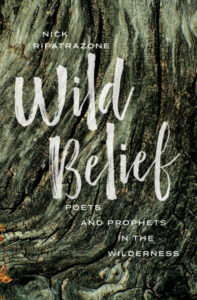 Wild Belief: Poets and Prophets in the Wilderness Nick Ripatrazone (Broadleaf Books) $25.99 OUR SALE PRICE = $20.79
Wild Belief: Poets and Prophets in the Wilderness Nick Ripatrazone (Broadleaf Books) $25.99 OUR SALE PRICE = $20.79
This brand new hardback is one of my favorite books this season and I simply couldn’t put it down. It isn’t directly about creation or in the genre of “nature writing” (although the long and gorgeously written introduction is, indeed. Ripatrazone knows his north Jersey watershed well and writes beautifully about the flora and fauna he and his family see in their local hikes.)
Yes, the book invites us to explore the spirituality of the wilderness. But it does this by way of literary reflection. Ripatrazone is a college lit prof and culture editor for Image Journal. He wrote the significant (and significantly reviewed) Longing for an Absent God: Faith and Doubt in Great American Fiction which showcased his considerable literary insights (especially about Catholic novelists and his own skillful writing chops himself.)
Wild Belief is an ingeniously arranged study of various faith-based literary figures who wrote about the wilderness, whose own encounters with the wild creation (and the wild God of creation) formed their souls and informed their writing projects. Poets and prophets, indeed.
First, Rip (man, I hope that’s his nickname) offers a very good introduction to the topic in a strong opening chapter “What is the Wilderness” drawing (naturally) on Stegner et al. He moves to the nature of prophecy (quoting Merton, among other poets and ecologists and Bible scholars) and explores how, in the Bible, God shows up in nature (and, especially, in the motif of the desert in both the Older and Newer Testaments.)
In each remaining chapter he covers one or sometimes two writers, each with a certain sort of theme that makes them good conversation partners. Professor Ripatrazone offers really good biography of these writerly characters and in inspiring, helpful, teacherly, ways, highlights key lines from their work. Reading Wild Belief is like taking a whole college class and it’s the kind you would never, ever miss, even if you might want to take a stroll through the outdoors right afterwards. I wonder if he’s the kind of teacher who, on a warm Spring day allows the class to meet outdoors.
Space here does not allow – and it is a bit above my own pay grade, anyway – to studiously review these informative chapters. But here’s the summary. I hope you are inspired to order it from us. It’s really, really good.
After the first two excellent general chapters get starts with a poet/priest you most likely know of. (Heck, Eugene Peterson used one of this poet’s lines as a book titles more than once.) It’s a chapter called “Wild Creativity” where explores the life and faith and poetry and aesthetics of Gerard Manley Hopkins. This is nearly worth the price of the book and I was very, very glad for this good chapter.
The next chapter, again, was stellar – Ripatrazone calls this one “Stewards of the Gloriously Indifferent” by comparing and contrasting two contemporary writers, Wendell Berry and Terry Tempest Williams. Again, this is well worth reading, especially if you’ve taken up either of these authors. (I know I don’t have to tell you how important the Kentucky famer Mr. Berry is, but I do hope you’ve read some Williams, at least Refuge and Red; I recall reviewing here at BookNotes her remarkable Finding Beauty in a Broken World.) Rip brings these two authors together and I leaned in to every word.
The next two chapters explored the life and work of Jim Harrison, Thomas McGuane, and William Everson; the Everson chapter is called “A Tremendous Sublime.” This was mostly new ground for me but was so interesting – for those interested in the interface of faith and writing and for those interested in the interface of writing and wilderness and nature.
Wild Belief moves next to a chapter many will love as it explores the life and work of Mary Oliver and W.S. Merwin under the heading of “Salvific Wilderness.” Oh my, this is rich and will not only give you a vision for the great outdoors, but will help you read these writers with an awareness of their unique, often Christian, creation-based worldviews.
We’re shelving a copy of this great book under literary criticism here in the shop and another under nature writing. While it is more technically the former, it moves us to the latter and offers, as Ripatrazone’s conclusion puts it, “A Clearing in the Wilderness.” By drawing on Toni Morrison’s Beloved, Ed Abbey’s legendary Desert Solitaire (I was waiting for him to show up!) John McPhee’s writings on the Jersey Pine Barrens, and Pope Francis’s ecological encyclical Laudato si’, Ripatrazone invites us to see afresh, to look for a clearing, to enter a fertile transformative spirituality. Kudos to the recent publisher Broadleaf for bringing this kind of good and interesting and generative book to us. Highly recommended.
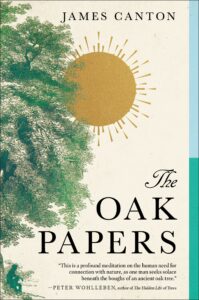 The Oak Papers James Canton (HarperOne) $27.99 OUR SALE PRICE = $19.99
The Oak Papers James Canton (HarperOne) $27.99 OUR SALE PRICE = $19.99
I was hooked on this literary and thoughtful memoir by the first few pages where the author tells of visiting a tree in his home region of Essex, England, that was eight hundred years old. “The tree was a mere sapling when the Magna Carta was signed, when King John reigned over England,” Canton plainly writes. I read that line three times trying to let it sink in.
We recently needed to have a three-story tree behind our house brought down and despite the excitement of the mechanics of it all – the loud buzzing from morning to evening, leaving us with a middle chunk of trunk that weighted over 10,000 pounds – it was very sad for me. I’ve been almost obsessed with wondering how old it was. (Yes, yes, we can count the rings, sort of.) But let’s face it, what I thought was old and, in its prime, even majestic, was dwarfed by the ancient oak described in this splendid, lyrical journey about the mysteries and splendors of life in God’s good creation.
As Canton goes to his beloved tree he soon learns that it is the only one remaining from an ancient grove – some of the trees had stood there for a thousand years! – that was egregiously chopped down in the 1950s in the name of progress. (Progress! Why left-leaning folks call themselves “progressives” these days is beyond me as that modern idol often leaves much ruin in its wake.) Canton visits his tree and tells us much about it. As one reviewer put it, the book “shows us how paying attention to our gnarled green elders can reveal rich layers of culture, psychology, and ecology.” If you liked (or were intrigued by) the much-discussed The Hidden Life of Trees by Peter Wohlleben – who himself calls it a “profound meditation” – you will certain enjoy The Oak Papers. Novelists, poets, scientists and naturalists have all weighed in, saying it is a book of magic, of perception, of great love.
By the way, speaking of trees, I have reviewed it before, but you may want to know, that the paperback version of Matthew Sleeth’s lovely Reforesting Faith just came out from Waterbrook ($16.00.) In a way, it is the grand overview of the unfolding drama of the whole Bible shown by way of trees in Scripture. The subtitle only explains some of what is going on in that fine little volume: “What Trees Teach Us About the Nature of God and His Love for Us.” We still have the neat, slim, hardback, and now this nice new paperback.
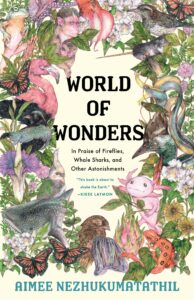 World of Wonders: In Praise of Fireflies, Whale Sharks, and Other Astonishments Aimee Nezhukumatathil (Milkweed Editions) $25.00 OUR SALE PRICE = $20.00
World of Wonders: In Praise of Fireflies, Whale Sharks, and Other Astonishments Aimee Nezhukumatathil (Milkweed Editions) $25.00 OUR SALE PRICE = $20.00
This book came out last fall to enthusiastic acclaim and I’ve been wanting to celebrate it here ever since. Ms Nezhukumatathil is an esteemed poet of mixed ethnicity, a lovely writer, delightful thinker and upbeat teacher. Her previous books of poetry have been well-received and her work has been anthologized in some prestigious poetry collections; it is notable for someone so young to be rising in serious literary circles. (Her most recent collection of poems is done with her very popular friend, the poet and essayist and urban gardener, Ross Gay.) She is a professor of English and teaches writing (and environmental literature) in the MFA program at the University of Mississippi
This recent, slim, hardback book – it’s a Milkweed Edition! — is a collection of lovely essays crafted from beautiful prose explaining (mostly) various animals and plants (with illustrations, nicely, if whimsically done, by Fumi Nini Nakamura.) Yep, this is nature writing that is not overly dense, not too intense, but slowly catches up to readers in ways that are revealing of her life as a minority woman growing up in a white culture. It includes some philosophizing and some science and some personal narrative, as most of our most engaging natural history books do. I might describe it almost as a memoir, but, geesh, she writes about colorful dancing frogs and narwhals that swim upside down and weird salamanders called axolotls. With almost child-like wonder she really, really enjoys these creatures.
World of Wonders really is about the nature of these animals, even as she invites us to “wander and wonder.” (Don’t you love the word “astonishments” in the subtitle?) Scott Russell Sanders calls the essays “praise songs of a poet working brilliantly in prose” It’s entertaining and enjoyable and yet, again, there is more going on than meets the eye at first blush. It was named the “Book of the Year” by the Barnes & Noble bookstore chain. As the prestigious Kirkus Review says, “Aimee Nezhukumatathil’s writing dazzles with the marvel of being fully alive.” NPR said at the end of 2020 that it was, “Hands down, one of the most beautiful books of the year.”
World of Wonders, kind of like Aimee, is flabbergasted, gobsmacked, and astonished with glee by all kinds of creatures and phenomena, all kinds of kin, from flamingos to catalpas, from monsoons to corpse flowers, from dancing frogs to axolotls. — Ross Gay, Poets & Writers
In thirty bewitching essays, Nezhukumatathil spotlights natural astonishments raining from monsoon season in India to clusters of fireflies in western New York, each one a microcosm of joy and amazement. With her ecstatic prose and her rapturous powers of insight, Nezhukumatathil proves herself a worthy spiritual successor to the likes of Mary Oliver and Annie Dillard, setting the bar high for a new generation of nature writers. — Esquire, Best Books of Fall 2020
Aimee Nezhukumatathil’s World of Wonders is the first book to make me feel like a firefly as much as it reminds me I’m still a black boy playing in Central Mississippi woods. The book walks. It sprints. It leaps. Most importantly, the book lingers in a world where power, people, and the literal outside wrestle painfully, beautifully. This book is a world of wonders. This book is about to shake the Earth. — Kiese Laymon
These are the praise songs of a poet working brilliantly in prose. Each essay compresses a great deal of art and truth into a small space, whether about fireflies or flamingos, monkeys or monsoons, childhood or motherhood, or the trials and triumphs of living with a brown skin in a dominant white world. You will not find a more elegant, exuberant braiding of natural and personal history.” — Scott Russell Sanders
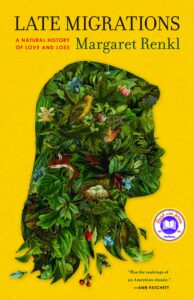 Late Migrations: A Natural History of Love and Loss Margaret Renkl (Milkweed Editions) $16.00 OUR SALE PRICE = $12.80
Late Migrations: A Natural History of Love and Loss Margaret Renkl (Milkweed Editions) $16.00 OUR SALE PRICE = $12.80
Those who love good “nature writing” (and who know Orion magazine) may recognize the publisher “Milkweed Editions” as a fine Minnesota-based publishing imprint that always does a very classy job. Late Migrations is a wonderfully done work with full color art pieces by Billy Renkle supplementing the glorious, vivid, if at times unusual prose.
I forget when we first heard of this; Renkl is a New York Times opinion writer but maybe it was on NPR who called it “magnificent.” I know what most made me want to get it was the New York Times Book Review claim that it was “equal parts Annie Dillard and Anne Lamott with a healthy sprinkle of Tennessee dry rub thrown in.” How can you resist that?
Late Migrations is not firstly a book of natural history, however. It is a collection of sometimes very short pieces, essays, really, that hang together and unfold as Renkl tells of her unforgettable parents, her family, and the “bittersweet moments that accompany a child’s transition to caregiver.” It is said to “ring with rapture and heartache” and it does indeed offer astonishment about the natural world. The natural world she speaks of is mostly around her suburban Nashville home.
I hope you know the spectacularly creative and rich novel (about trees) called The Overstory by Richard Powers. Powers writes of Late Migrations:
A compact glory, crosscutting between consummate family memoir and keenly observed backyard natural history. Renkl’s deft juxtapositions close up the gap between humans and nonhumans and revive our lost kinship with other living things.
As one reviewer said, “Conjure your favorite place in the natural world: beach, mountain, lake, forest, porch, windowsill, rooftop? Precisely there is the best place in which to savor this book.” Good advice! What a book!
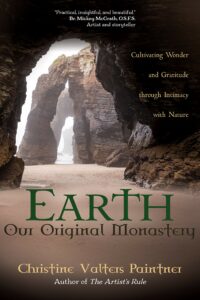 Earth Our Original Monastery: Cultivating Wonder and Gratitude through Intimacy with Nature Christine Valters Paintner (Sorin Books) $15.95 OUR SALE PRICE = $12.76
Earth Our Original Monastery: Cultivating Wonder and Gratitude through Intimacy with Nature Christine Valters Paintner (Sorin Books) $15.95 OUR SALE PRICE = $12.76
Many of our customers love Chrstine Valters Paintner, a Celtic spiritual writer who has done bunches of books on everything from contemplative photography to lectio divino, from Celtic spiritual practices to her acclaimed The Artists Way. Her most recent (which we have, of course, is called Sacred Time, about being intentional about embracing the church calendar and sensing God’s call to order our days in more spiritual ways.) About a decade ago she did a book that I sometimes list when I’m going recommending books about finding God in the outdoors called Water, Wind, Earth & Fire: The Christian Practice of Praying with the Elements.
This one that came out less than a year ago plays with the idea of a monastery, and suggests that Earth is that first place where we meet with God, “where we learn our most fundamental prayers, participate in each day’s liturgy of praise,” and experience the wisdom of God embedded in the seasons. As the back cover says, “She explores monks, mystics, and saints who have experiences the goodness of the Divine in nature and invites us to find solace and spiritual revelation in the wonder of God’s creation.”
This book does indeed give us poetic and artful glimpses into this exact process, but, significantly, it gives us specific practices (as mundane as a ritual with herbal tea to feeding birds.) There are litanies and prayers, some more complex than others, some deeply theological (like taking a walk while pondering Gerard Manley Hopkin’s notion of “inscape”) to others that are more reflective, like creating poems prompted by her gentle invitations.
Some may think this verges on pantheism and others may not fully appreciate the interfaith perspective on a few pages, citing Buddhist poets or indigenous practices, but most if overtly Christian, Biblical, and rooted in stories of saints who communed well with land and creatures.
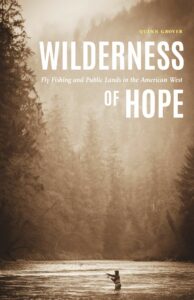 Wilderness of Hope: Fly Fishing and Pubic Lands in the American West Quinn Grover (Bison Books/University of Nebraska Press) $26.95 OUR SALE PRICE = $21.56
Wilderness of Hope: Fly Fishing and Pubic Lands in the American West Quinn Grover (Bison Books/University of Nebraska Press) $26.95 OUR SALE PRICE = $21.56
Fly fishing books are quite a sub-genre within outdoors writing, perhaps because – who knows? – those who tie flies are a bit more literary and the artfulness of the craft lends itself to reflection and poetic writing. Maybe it’s the legacy of Izaak Walton and Norman Maclean. (And, while I’m digressing, let me say again that The River Why by James David Duncan is one of my all time favorite novels ever, and is, on the surface, about the debate between bass fishing with worms versus fly fishing as a kid fishes his way up a mysterious river.)
And so, I thought Wilderness of Hope might have some of this fisherly charm, but I also was struck by the subtitle. What is “public land” and why does it matter? (Ohhh, I hope you know Wallace Stegner’s old essay on that, and Wendell Berry’s contribution.) I didn’t know if Grover was as mad at the then-President Trump (and Republican Presidents before him) for his desecrating moves to sell off wilderness preserves and allow oil drilling, but I hoped so. I don’t know what I was looking for – gentle fly-fishing stories and some anti-Trump zeal that was truly conservationist?
Well, these literary meditations are from his life and as Braden Hepner puts it, “conveys the mystery and pull of the trout rivers that run through the American West.” Yes, he is like Annie Dillard or even (as Hepner says) like Thoreau. It will deepen “your capacity for wonder” and seek time to ponder what matters in your life and family (which just might be finding a way to spend more time fishing.)
And, yes, Wilderness of Hope did not disappoint my hope for a political statement about the value of wilderness – indeed, finding wild and native trout on our public lands happens because we’ve allowed them to be. Grover makes a powerful case for the role of vast public spaces and develops a bit of a political ethic that includes preserving and protecting what must be seen as not mere material resources but are somehow nearly spiritual in value.
As many reviewers have noted, Quinn Grove is a truly great writer; he teaches English at Brigham Young University in Idaho. In this marvelous volume he offers “long luxurious passages on nature’s elusive tributaries.” Through his storytelling and meandering he lifts up “places worth knowing.” And, I’d say, places worth protecting.
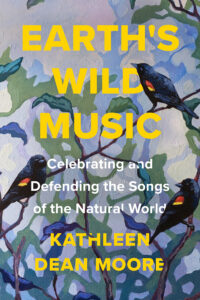 Earth’s Wild Music: Celebrating and Defending the Songs of the Natural World Kathleen Dean Moore (Counterpoint Press) $26.00 OUR SALE PRICE = $20.80
Earth’s Wild Music: Celebrating and Defending the Songs of the Natural World Kathleen Dean Moore (Counterpoint Press) $26.00 OUR SALE PRICE = $20.80
A few weeks ago I wrote a quick announcement about this new volume by Kathleen Dean Moore, and since it fits so properly – urgently, event – right here, I’ll reprise that little shout out. This splendid new hardback means a lot to me and I hope you’ll consider it.
I have not had the opportunity to write much about the beautiful, eloquent, interesting, captivating, and often very moving nature essays of Kathleen Dean Moore for a while – her last was a somewhat more political and philosophical study, the important Great Tide Rising: Moral Courage in a Time of Planetary Change and then the very fun novel, Piano Tide, both which we’ve announced at BookNotes. This recent release is sort of a “greatest hits” collection of her earlier books that I loved so much, drawing also from articles never in book form, but mostly including excerpts from beautiful collections of memoir and natural history and storytelling about her experiences in the outdoors such as Holdfast, Riverwalking, Wild Solace, and the wonderful Pine Island Paradox. The organizing theme whereby certain excerpts and essays suggested themselves is around wild sounds, the music of creation. What a great gift for those who appreciate profound and enjoyable nature writing. Earth’s Wild Music is a gem.
Here is what the publisher promises about it:
“In her newest collection, Moore selects essays that celebrate the music of the natural world as a reminder of what can be taken from us-the yowl of wolves, tick of barnacles, laughter of children, shriek of falling mountains. Alongside these selections are brand new essays born from the sorrow and iniquity of this new age of extinction, all bearing witness to the glories of this world and the sins against it. Each group of essays moves, as Moore herself has been moved, from celebration to lamentation to bewilderment to the determination to act. In Earth’s Wild Music, Moore reminds us that whatever is left of the planet after its pillaging is the world in which those who remain must live. Whatever genetic song-lines, whatever fragments of whale-squeal and shattered harmonies are left, that’s what evolution will have to work with. Music is the shivering urgency and exuberance of life on-going. In a time of terrible silencing, Moore asks, who will forgive us if we do not save the songs?”
I love that reviewer Leonoa Todaro (in Catapult) says Moore is “Steeped in nature, brewing alternately with love and rage.” Yes! And then, this: “Moore writes at the intersection of ode and alarm inhabited by the spirits of Mary Oliver and Rachel Carson.” You can see why I wanted to list this one again.
Here is the helpful starred review from the sober industry journal, Booklist:
Exceedingly knowledgeable, experienced, and expressive, this former philosophy professor shares tales of her adventures in the far north, prairies, woods, and beyond, all while emphasizing Earth’s gloriously varied soundscape: the songs of birds, frogs, and whales; the calls of bats and wolves . . . Moore details all that we’re losing to climate change, spiking gorgeously precise descriptions and dramatic tales of wildlife encounters with grim statistics about the escalating die-off of birds and other species, the ‘great starving’ underway in the oceans, and the ongoing destruction of forests and wetlands . . . We must prevent the looming silence, Moore asserts, by forming a chorus of voices raised in solidarity with all of Earth’s wondrous and essential life forms.
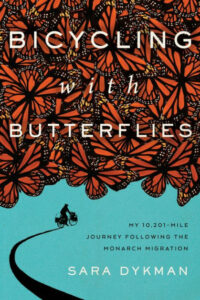 Bicycling with Butterflies: My 10,201-Mile Journey Following the Monarch Migration Sara Dykman (Timber Press) $27.95 OUR SALE PRICE = $22.36
Bicycling with Butterflies: My 10,201-Mile Journey Following the Monarch Migration Sara Dykman (Timber Press) $27.95 OUR SALE PRICE = $22.36
Okay, where do we shelve this, dear readers? Under “nature” as the book itself suggests? Under outdoor recreation? Travel? It is all of that as you can tell from the very clear title – this is the story of a woman who road her bike from Mexico to Canada and back, following the best she could a migrational kaleidoscope (yep, that’s the word for it, or, alternately, a flutter) of Monarch butterflies.
Told with a good eye for detail, she takes us along her unusual adventure. As Robert Michael Pyle (author of Chasing Monarchs: Migrating with the Butterflies of Passage) says of it
Sara Dykman followed the extraordinary monarch migration by bicycle, and came back to write about it. She has recorded it well. Her almost incredible account captures the animal itself, the continent it crosses, and its plight with style and deep connection.
I’ve read a few other good books about people doing bike trips across the lands. I’m sure you’ve read hiking books, those books about guys on foot. They are always fun, but this one has this extra level of purpose and this extra degree of beauty on offer. She knows how fragile our eco-systems are and in a way this mostly fun adventure tale is a wake-up call, yet again, from those often missed on the edges; that is, it reminds us to be aware of the hurting on the margins. Even if the margins are as glorious as a kaleidoscope of Monarchs.
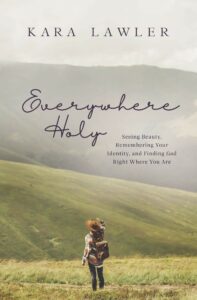 Everywhere Holy: Seeing Beauty, Remembering Your Identity, and Finding God Right Where You Are Kara Lawler (Thomas Nelson) $17.99 OUR SALE PRICE = $14.39
Everywhere Holy: Seeing Beauty, Remembering Your Identity, and Finding God Right Where You Are Kara Lawler (Thomas Nelson) $17.99 OUR SALE PRICE = $14.39
I don’t want to drift too far afield from our theme of nature writing and this book could just as easily be shelved (as we do in our store) with other books about finding God in the ordinary, sort of the “spirituality of the mundane” as we’ve written about here before. From Kathleen Norris’s little The Quotidian Mysteries to the popular The Liturgy of the Ordinary by Tish Warren to Glory Happening: Finding the Divine in Everyday Places by Kaitlin Curtice and so many more, this narrative by Lawler could fit right in.
I mention it here, briefly, though, because throughout this memoir she does write nicely with a storyteller’s voice, helping us see God “hidden in plain site” (yes) but also to help us appreciate creation around us. Lawler writes wonderfully about her Western Pennsylvanian mountains, about flowers and birds and gardens and tea, vacations and hikes, work and play, stars, noticing, always noticing, the good stuff. (She mentions a tragedy on the Susquehanna River, too, and a child’s scary bout with Lyme Disease.) Everywhere Holy isn’t about the outdoors, as such, and she certainly isn’t a natural history writer like, say, Dillard or Moore, but she does write nicely about what she sees. For some of us, this is a good way in, and we happily recommend it.
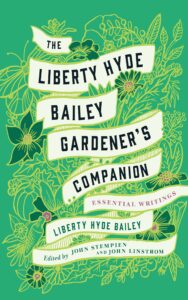 The Liberty Hyde Bailey Gardener’s Companion: Essential Writings Liberty Hyde Bailey, edited by John A. Stempien & John Linstrom (Cornell University Press) $26.95 OUR SALE PRICE = $21.56
The Liberty Hyde Bailey Gardener’s Companion: Essential Writings Liberty Hyde Bailey, edited by John A. Stempien & John Linstrom (Cornell University Press) $26.95 OUR SALE PRICE = $21.56
For those who have followed the history of faith-based, Christian views of Earth-keeping and creation-care and the dignity of rural life, the name from the very early 20th century, Liberty Hyde Bailey, might ring a bell. He wrote lyrical poetry and prose and was considered my many to be “The Father of Modern Horticulture.” (Not to mention one of the founders of 4-H.) I first learned of him when a group organized in part by Ron Sider, which became the Evangelical Environmental Network, reprinted some of his early work decades ago. In a sense he was a precursor to our contemporary ecological worldview and certainly an influence on the likes of Wendell Berry. As Amy Halloran, author of The New Bread Basket puts it, “Bailey spoke to an early generation of environmentalists and this collection brings his affection for plants and nature to contemporary ears.” Indeed, as she suggests, his affection is contagious. Let us hope so.
This “gardener’s companion” is a major contribution to LHB studies and a delightful gift to anyone wanting a poetic and wise view of the holiness of the earth and the goodness of the seasons. He writes, here, as Mary Swander (the Poet Laureate of Iowa and editor of Farmscape) writes on the back cover, about “the cycles of nature, from the blossoms of his beloved apple trees in the spring, to the ripening of gourds in the fall, to the snow falling on the greenhouse in winter.”
The Liberty Hyde Bailey Gardener’s Companion is a very handsome hardback, almost 300 pages, including older essays, magazine pieces, columns, and copious drawing and illustrations, even poems, published on gardening, all compiled and published together for the first time. There is wit and grace here, and solid advice and lovely encouragement for anyone who wants a classic vision for caring for their corner of God’s green Earth. As Bailey wrote in 1941, nearer the end of his career, he hoped his writing “contributes to the understanding and dignity of plant-growing. The grower should be proud to be in the company of so many kinds of plants.” Nice, huh?
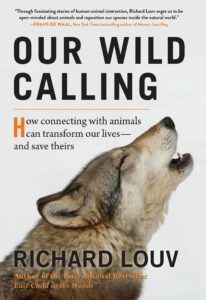 Our Wild Calling: How Connecting with Animals Can Transform Our Lives – and Save Theirs Richard Louv (Algonquin Books of Chapel Hill) $27.95 OUR SALE PRICE = $22.36
Our Wild Calling: How Connecting with Animals Can Transform Our Lives – and Save Theirs Richard Louv (Algonquin Books of Chapel Hill) $27.95 OUR SALE PRICE = $22.36
I suppose you have at least heard of Louv’s much-discussed and very important Last Child in the Woods: Saving Our Children from Nature-Deficit Disorder. Well, as the always-wise Bill McKibben says, “Richard Louv has done it again!” McKibben continues, “A remarkable book that will help everyone break away from their fixed gaze at the screens that dominate our lives.”
The rave reviews just on the back cover are extraordinary – “a wondrous tapestry”, “powerful and a must-read”, “brilliant, wise, eloquent.” David Orr, a very important ecological educator in Ohio says it is “a powerful summons.” Indeed.
Can this affirmation of our essential connection to animals help cure what ails us, help heal our loneliness and boredom, our disconnection and broken relationships, our ennui and mental health struggles? I think at least somewhat. It isn’t the only thing, but it is (Biblically speaking, I might add) a key thing. Richard Louv is right to connect us to nature and, in this case, to animal creatures.
I am sure I’d have some quibbles philosophically about his assumptions about the nature of humans – I resolutely do not want to say we are animals for theological reasons, but I get that we are (as Francis of Assisi and Francis of L’Abri both said) we are brothers and sisters to our fellow creatures. The great Dutch primatologist Frans de Waal notes that Louv at least urges us to be “open-minded about animals and reposition our species inside the natural world. “
We have a good number of books about animals, and pets, even grieving the loss of pets. This one looks powerful and foundational, even if you may not agree with all of it. Wow.
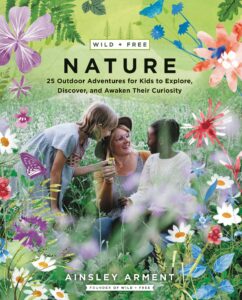 Wild + Free Nature: 25 Outdoor Adventures for Kids to Explore, Discover, and Awaken Their Curiosity Ainsley Arment (HarperOne) $22.99 OUR SALE PRICE = $18.39
Wild + Free Nature: 25 Outdoor Adventures for Kids to Explore, Discover, and Awaken Their Curiosity Ainsley Arment (HarperOne) $22.99 OUR SALE PRICE = $18.39
I suppose some of our readers — the younger and hipper ones, I guess — are aware of the “Wild + Free” brand. You maybe follow them on insta or at least have visited their popular facebook pages. This book is, as you’d expect, just dripping with charm and loveliness, eye candy for those who love cute kids with a certain aesthetic and vision. Ainsley Arment and the Wild + Free community have curated (of course they have) a very nice array of activities that can lead kids to wander, capture, savor, and be involved in the great outdoors.
There are programs and ideas such as having a backyard mud kitchen, making edible flower and herb cookies, doing an heirloom seed exchange, learning Plein air painting, cultivating mushrooms and gardening, even in the city. As they say, this was “created by parents and loved by kids,” It’s really nicely done and makes this stuff doable and joyful. Cheers!
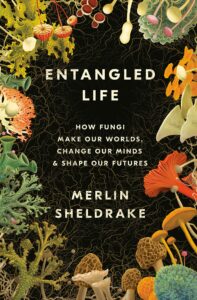 Entangled Life: How Fungi Make Our Worlds, Change Our Minds & Shape Our Futures Merlin Sheldrake (Random House) $18.00 OUR SALE PRICE = $14.40
Entangled Life: How Fungi Make Our Worlds, Change Our Minds & Shape Our Futures Merlin Sheldrake (Random House) $18.00 OUR SALE PRICE = $14.40
We heard an interview with Sheldrake on one of the NPR talk shows (1 A, maybe, or Fresh Air) and it was memorizing. I’ve yet to crack this open, but we’re glad to be a faith-based bookstore that also wants to share cutting edge books of popular science, books that are well written and help us understand better our place in God’s good world. Sure we can get easy inspiration from sunsets and beautiful trees, but fungi? Well, yes.
And, according to serious, intellectual reviewers, the book “…expanded my appreciation of what it means to be alive” and shows that “the universe is sublime.” Helen Macdonald, author of H Is for Hawk and the great collection Vesper Flights, says Entangled Life is “one of those rare books that can truly change the way you see the world around you”
Oh if more of our straight up books about Christian faith and discipleship had such an impact on readers.
“I fell in love with this book. Merlin is a scientist with the imagination of a poet and a beautiful writer… This is a book that, by virtue of the power of its writing, shifts your sense of the human. . . . It will inspire a generation to enter mycology.” –Michael Pollan (Bay Area Book Festival, 2020)
“Dazzling, vibrant, vision-changing . . . a remarkable work by a remarkable writer, which succeeds in springing life into strangeness again.” –Robert Macfarlane, author of Underland
“Reading this book, I felt surrounded by a web of wonder. The natural world is more fantastic than any fantasy, so long as you have the means to perceive it. This book provides the means.” –Jaron Lanier, author of You Are Not a Gadget
Nearly every page of this book contained either an observation so interesting or a turn of phrase so lovely that I was moved to slow down, stop, and reread. . . . This book rocked me into remembering that nature, especially fungal nature, is big and encompassing and creative and destructive. It reminded me that fungi are, like the Universe, sublime.” –Rob Dunn, Science magazine
Merlin Sheldrake is a biologist and a writer. He received a Ph.D. in tropical ecology from the University of Cambridge for his work on underground fungal networks in tropical forests in Panama, where he was a predoctoral research fellow of the Smithsonian Tropical Research Institute. Pretty impressive, eh?
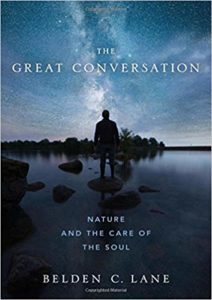 Belden C. Lane (Oxford University Press) $29.95 OUR SALE PRICE = $23.96
Belden C. Lane (Oxford University Press) $29.95 OUR SALE PRICE = $23.96
I have reviewed the amazing, important, provocative books by Belden Lane on several occasions and I simply couldn’t do this list – even though most of the ones we are naming are fairly recent – without giving a quick nod to this 2019, previously mentioned hardback. Lane, who teaches theology at Saint Louis University, has written dense and scholarly works including a book on the history of religious environmentalism and one on spirituality within the Reformed tradition. (Lane is a PCUSA clergyperson.) Most popular, though, are two that are somewhat similar.
The Solace of Fierce Landscapes: Exploring Desert and Mountain Spirituality (Oxford University Press; $17.95) weaves together a memoir of caring for his mother who has Alzheimer’s and cancer and meditations of finding solace in significant hikes into severe deserts and mountains. He has studied well the desert fathers and knows much about the mystical traditions of the ancient church and he is an avid and serious backpacker, so this book became exceptionally popular among those who care about these things.
Even more popular is the brilliantly conceived Backpacking with the Saints: Wilderness Hiking as Spiritual Practice (Oxford University Press; $24.95.) In this mountaineering memoir, he takes a certain spiritual classic with him on a series of hikes, each hike described in light of his engagement with the work he took with him on that trip and its particular theme. They are well ordered, each chapter telling of the next leg of the journey. With chapters like “The Irish Wilderness and Columba of Iona” and “Rockpile Mountain and Thomas Trahern” and “The Maze in Canyonlands and John of the Cross” and “Mt. Whitney and Martin Luther” you can get the idea; there is nothing in print like it and it is very interesting. After two wonderful introductory chapters, there are thirteen other trips documented, with companions as diverse as Teresa of Lisieux, Thomas Merton, and Mohandas Gandhi.
All of which is to lead us to this latest, The Great Conversation where Lane similarly takes a certain spiritual master, the work of a mystic or prophet or pray-er, to a certain location. It isn’t a trip or travelogue as much, and there is no trailhead or ascent or failure or returning home. He goes to a brother or sister in creation – a tree, a rock, a lake, or, I should say, places – deserts, islands, starfields, caves, rivers – and compares what he learns as he communes with them with what the great spirituality writers are teaching. He is confident, properly so, if one is Biblical, that creation can speak to him and he can, if humbled and in proper awe, enter “the great conversation.” Naturally (I use the word knowingly) he believes, also, that we can hear from God, perhaps in and even through creation. This is a landmark book, I think, deepening not only our “beyond stewardship” paradigm (as the book by that title from Calvin College Press puts it) but within the field of finding God in the natural world. As Richard Rohr puts it, this book is both “beautiful and true.”
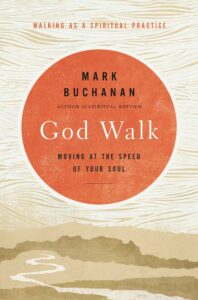
God Walk: Moving at the Speed of Your Soul Mark Buchanan (Zondervan) $25.99 OUR SALE PRICE = $20.19
We have raved about the wonderful God Walk: Moving at the Speed of Your Soul previously; I would read anything Mark Buchanan writes, I think, and he just keeps getting better and better as a great writer and profound spiritual guide. We so appreciate this exploration of the benefits of walking and of various sorts and styles of walking. It is the best book on the subject.
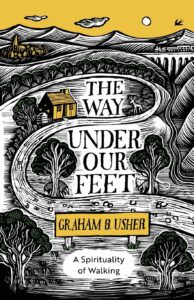 The Way Under Our Feet: A Spirituality of Walking Graham B. Usher (SPCK) $18.00 OUR SALE PRICE = $14.40
The Way Under Our Feet: A Spirituality of Walking Graham B. Usher (SPCK) $18.00 OUR SALE PRICE = $14.40
This new one, though, The Way Under Our Feet, is by an author we did not know; we order books in from the UK sometimes and this one struck us not only for the great title and subtitle but for the handsome wood-cut cover that I adore. Usher is an Anglican Bishop and a working ecologist so naming this book now just seems fabulously spot on. He’s literary and theological, offering great insights about a slow and careful lifestyle, about being attentive, also to the Earth around us, but to others and to our own interior lives. It is wide-ranging and lovely in that sense, but like with Buchanan’s. please don’t think of this as a simple field guide to exercise or a simplistic religious devotional. The Way Under Our Feet really is about the “social construction of reality” as one sociologist puts it, and is about how we see, how we lean into life. There are some nice stories and funny anecdotes but it is also more profound that you may realize. It is about, finally, experiencing life, from “remembering” to “going” and more. It is a book that you will learn much from and that you will not soon forget.
+++
Certainly any of this handful of books listed above would make great personal reads for your own enjoyment and edification. As the weather warms we hope you are able to be out more (even if we have good reason to avoid crowds.) These will help you appreciate your outdoor experiences more, I bet. Many would be fun to do with book clubs or small groups, I’d think.
![]() Ideally, some could be used as a foundation to inspire projects like the “Opening the Book of Nature” program created by Frederick Krueger and Vincent Rossi. Or, you could consider the brief and programmatic book (and leaders guide) by Robert Gottfried and Frederick Krueger called Living In An Icon: A Program for Growing Closer to Creation and to God (Church Publishing; $12.95. OUR SALE PRICE = $10.36.) I’ve mentioned it before and commend it again if you want to take some of these books above and apply them to an interactive and experiential Christian education and spiritual formation program. If you can’t find a faith community to do this with, why not call a friend and just do it yourselves. Living in An Icon is full of activities and reflections, Scripture and action, ways to bring the Bible down to Earth and our faith to life. Enjoy!
Ideally, some could be used as a foundation to inspire projects like the “Opening the Book of Nature” program created by Frederick Krueger and Vincent Rossi. Or, you could consider the brief and programmatic book (and leaders guide) by Robert Gottfried and Frederick Krueger called Living In An Icon: A Program for Growing Closer to Creation and to God (Church Publishing; $12.95. OUR SALE PRICE = $10.36.) I’ve mentioned it before and commend it again if you want to take some of these books above and apply them to an interactive and experiential Christian education and spiritual formation program. If you can’t find a faith community to do this with, why not call a friend and just do it yourselves. Living in An Icon is full of activities and reflections, Scripture and action, ways to bring the Bible down to Earth and our faith to life. Enjoy!
For those who want to think a bit more about this whole subject of human interaction with nature — God’s creation — and a theology of it all, our experiential education and spiritual formation as found it books listed above could be supplemented by any number of solid books on what we used to call “earth keeping” or “creation-care.” While protecting our groaning planet from the perils of our way of life (and the ugly government failure of its God-given calling to punish polluters) is not the topic of this column — we have lots of books on a theology of creation care and have written about them in other BookNotes, some of those books are stellar to help us get a solid Biblical framework.
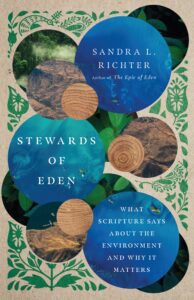 In other BookNotes we’ve promoted For the Beauty of the Earth: A Christian Vision of Creation Care by Steven Bouma-Prediger or Introducing Evangelical Eco-theology: Foundations in
In other BookNotes we’ve promoted For the Beauty of the Earth: A Christian Vision of Creation Care by Steven Bouma-Prediger or Introducing Evangelical Eco-theology: Foundations in 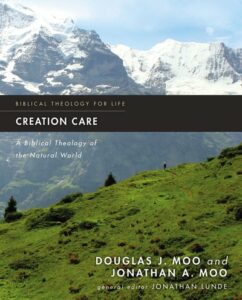 Scripture, Theology, History, and Praxis edited by Daniel Brunner, Jennifer Butler and A.J. Swoboda (both by Baker Academic.) We really appreciate Creation Care: A Biblical Theology of the Natural World in the excellent “Biblical Theology for Life” series by Zondervan. Not too long ago we highlighted the small but so solid Stewards of Eden: What Scripture Says about the Environment and Why It Matters published by IVP Academic. I do hope you recall our short review of Beyond Stewardship: New Approaches to Creation Care edited by David Warners and Matthew Kuperus Heun, published in 2019 by Calvin College Press which is a small collection of concise essays that are nearly brilliant. It’s a must for those who want to always be reforming their Christian worldview.
Scripture, Theology, History, and Praxis edited by Daniel Brunner, Jennifer Butler and A.J. Swoboda (both by Baker Academic.) We really appreciate Creation Care: A Biblical Theology of the Natural World in the excellent “Biblical Theology for Life” series by Zondervan. Not too long ago we highlighted the small but so solid Stewards of Eden: What Scripture Says about the Environment and Why It Matters published by IVP Academic. I do hope you recall our short review of Beyond Stewardship: New Approaches to Creation Care edited by David Warners and Matthew Kuperus Heun, published in 2019 by Calvin College Press which is a small collection of concise essays that are nearly brilliant. It’s a must for those who want to always be reforming their Christian worldview.
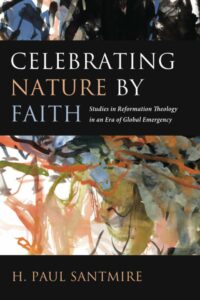 To these sorts of books I’ll now add the recent and very valuable Celebrating Nature by Faith: Studies in Reformation Theology in an Era of Global Emergency by H. Paul Santmire (Cascade) $25.00 OUR SALE PRICE + $20.00
To these sorts of books I’ll now add the recent and very valuable Celebrating Nature by Faith: Studies in Reformation Theology in an Era of Global Emergency by H. Paul Santmire (Cascade) $25.00 OUR SALE PRICE + $20.00
Santmire is one of those important theological voices that has influenced many creative leaders of the faith-based creation care movement. Accurately or not, I tend to think of him alongside of another great, pioneering Lutheran scholar on these things, Joseph Sittler. In any case, this recent volume has Santimire reflecting on “how to live with nature according to the Bible” and commends (not unlike the above mentioned Beyond Stewardship from Calvin University folks) moving from “stewardship to partnership.”
He does this by way of looking at Martin Luther’s theology of nature (“announcing theGod who is in, with, and under all things” and putting that into conversation with Jospeh Sittler’s vision of the cosmic Christian and “nature transfigured.” He offers an academic chapter called “The Theology of Nature as an Emergent Field of Promise” and invites “multidisciplinary reformation explorations.” Yes!! The final chapter is a first-person theological narrative which he calls “celebrating nature by faith” from which he choose his title of the whole book.
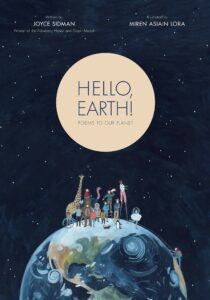 And then, there is this, one of may great children’s resources we might suggest. Hello Earth! Poems to our Planet is written by Joyce Sidman and illlustrated by Niren Asiaian Lorda (Eerdmans Books for Young Readers) $18.99 OUR SALE PRICE = $15.19
And then, there is this, one of may great children’s resources we might suggest. Hello Earth! Poems to our Planet is written by Joyce Sidman and illlustrated by Niren Asiaian Lorda (Eerdmans Books for Young Readers) $18.99 OUR SALE PRICE = $15.19
This is an oversized kids book, a moody and yet evocative hardback with great kid art, which has garnered lots of great reviews; Sidman is a Minnesota writer who has done books of poetry for children that have received the Newberry Honor Award and Caldecott awards as well. The “Eerdmans Books for Young Readers” imprint is honored by literary experts and beloved by librarians and those with an eye for particular artful books for children. This one, for grades 3 – 6, I’d say, is, as you can see, poetry — but poetry with a twist. These are poems to the Earth.
And the poet wrote them (in a reversal of a more common workflow) after viewing the artwork for each spread.
I think Sandra O’Connor, writing for School Library Journal, explains it well:
This understated book of poetry spotlights planet Earth. The text covers scientific theories, including plate tectonics and continental drift, conservation, and the human impact on the planet’s ecosystems. It is worth noting that Sidman did not write the poems first; rather, she worked off of the illustrations to create the stories. This unusual and unique workflow approach could be worth discussing with young readers. The artwork depicts Earth at a distance, and readers will feel as though they are omnipotent observers of the action happening on or beneath Earth’s surface. The soft color palette provides a soothing tone to even the fieriest concepts, like volcanic explosions. The clever illustrations present an “I Spy” experience for readers; they will enjoy uncovering what feels like secret moments in many of the spreads-boa constrictors quietly winding through the treetops and a couple stealing a kiss at a restaurant. Sidman’s poetry is conversational and spare, but it hits at the heart of the very human connection with Earth. Readers may be left wanting more, but that’s also reflective of how people may wish for more answers and solutions to mankind’s complicated relationship with the planet. A must-have for all schools and libraries that wish to maintain a current and vibrant poetry collection for young people.
It is very helpful if you would tell us how you prefer us to ship your orders. Although we can’t say here exactly what your order would cost since the weight and destination varies, you can use this as a thumbnail, general guide.
There are generally two kinds of US Mail options, and, of course, UPS. If necessary, we can do overnight and other expedited methods, too. We’re at your service.
- USPS has the option called “Media Mail” which is cheapest but slow and may be delayed. For one book, usually, it’s about $3.25.
- USPS has another option called “Priority Mail” which is about $7.00 for one or two books and that gets more attention than does “Media Mail.”
- UPS is more reliable but about $8.00 for one book or two to most places.
PLEASE LET KNOW KNOW WHAT SHIPPING METHOD YOU PREFER.
BookNotes

SPECIAL
DISCOUNT
20% OFF
ALL BOOKS MENTIONED
+++
order here
this takes you to the secure Hearts & Minds order form page
just tell us what you want to order
inquire here
if you have questions or need more information
just ask us what you want to know
Hearts & Minds 234 East Main Street Dallastown PA 17313
read@heartsandmindsbooks.com
717-246-3333
We are still not allowing in-store browsing due to our commitment to public health and the common good (not to mention the safety of our staff and customers.) We are doing outdoor, backyard service, curb-side delivery, and can show any number of items to you if you call us from our back parking lot. We are eager to serve and grateful for your patience as we all work to mitigate the ongoing pandemic. Of course, we’re happy to ship books anywhere.
We are here 10:00 – 6:00 Monday – Saturday; closed on Sunday. Thanks for your support.
